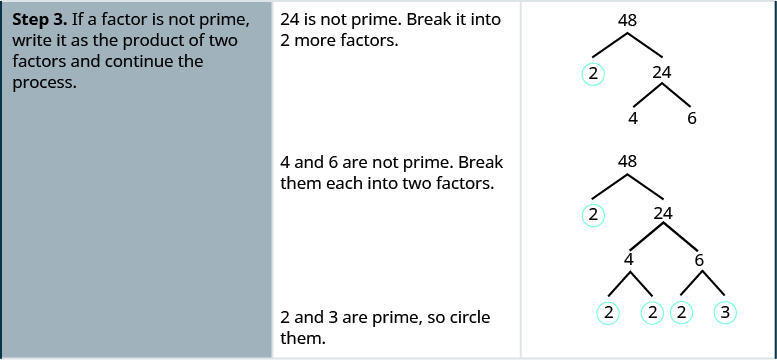| << Chapter < Page | Chapter >> Page > |
Determine whether 4,962 is divisible by 2, by 3, by 5, by 6, and by 10.
by 2, 3, and 6
Determine whether 3,765 is divisible by 2, by 3, by 5, by 6, and by 10.
by 3 and 5
In mathematics, there are often several ways to talk about the same ideas. So far, we’ve seen that if m is a multiple of n , we can say that m is divisible by n . For example, since 72 is a multiple of 8, we say 72 is divisible by 8. Since 72 is a multiple of 9, we say 72 is divisible by 9. We can express this still another way.
Since we say that 8 and 9 are factors of 72. When we write we say we have factored 72.

Other ways to factor 72 are Seventy-two has many factors: 1, 2, 3, 4, 6, 8, 9, 12, 18, 36, and 72.
If then a and b are factors of m .
Some numbers, like 72, have many factors. Other numbers have only two factors.
A prime number is a counting number greater than 1, whose only factors are 1 and itself.
A composite number is a counting number that is not prime. A composite number has factors other than 1 and itself.
The counting numbers from 2 to 19 are listed in [link] , with their factors. Make sure to agree with the “prime” or “composite” label for each!

The prime number s less than 20 are 2, 3, 5, 7, 11, 13, 17, and 19. Notice that the only even prime number is 2.
A composite number can be written as a unique product of primes. This is called the prime factorization of the number. Finding the prime factorization of a composite number will be useful later in this course.
The prime factorization of a number is the product of prime numbers that equals the number.
To find the prime factorization of a composite number, find any two factors of the number and use them to create two branches. If a factor is prime, that branch is complete. Circle that prime!
If the factor is not prime, find two factors of the number and continue the process. Once all the branches have circled primes at the end, the factorization is complete. The composite number can now be written as a product of prime numbers.
Factor 48.




We say is the prime factorization of 48. We generally write the primes in ascending order. Be sure to multiply the factors to verify your answer!
If we first factored 48 in a different way, for example as the result would still be the same. Finish the prime factorization and verify this for yourself.

Notification Switch
Would you like to follow the 'Elementary algebra' conversation and receive update notifications?